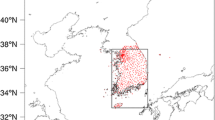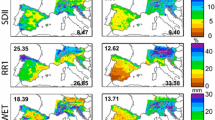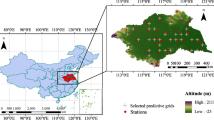Abstract
This study investigates the effects of horizontal resolution, cumulus parameterization scheme (CPS), and probability forecasting on precipitation forecasts over the Korean Peninsula from 00 UTC 15 August to 12 UTC 14 September 2013, using the limited-area ensemble prediction system (LEPS) of the Korea Meteorological Administration. To investigate the effect of resolution, the control members of the LEPS with 1.5- and 3-km resolution were compared. Two 3-km experiments with and without the CPS were conducted for the control member, because a 3-km resolution lies within the gray zone. For probability forecasting, 12 ensemble members with 3-km resolution were run using the LEPS. The forecast performance was evaluated for both the whole study period and precipitation cases categorized by synoptic forcing. The performance of precipitation forecasts using the 1.5-km resolution was better than that using the 3-km resolution for both the total period and individual cases. The result of the 3-km resolution experiment with the CPS did not differ significantly from that without it. The 3-km ensemble mean and probability matching (PM) performed better than the 3-km control member, regardless of the use of the CPS. The PM complemented the defect of the ensemble mean, which better predicts precipitation regions but underestimates precipitation amount by averaging ensembles, compared to the control member. Further, both the 3-km ensemble mean and PM outperformed the 1.5-km control member, which implies that the lower performance of the 3-km control member compared to the 1.5-km control member was complemented by probability forecasting.











Similar content being viewed by others
References
Arakawa, A., Jung, J.H., Wu, C.M.: Toward unification of the multiscale modeling of the atmosphere. Atmos. Chem. Phys. 11(8), 3731–3742 (2011)
Bryan, G.H., Wyngaard, J.C., Fritsch, J.M.: Resolution requirements for the simulation of deep moist convection. Mon. Weather Rev. 131, 2394–2416 (2003)
Byun, K. Y., and Lee, T. Y.: Remote effects of tropical cyclones on heavy rainfall over the Korean peninsula – statistical and composite analysis. Tellus, 64A (2012). https://doi.org/10.3402/tellusa.v64i0.14983.
Craig, G.C., Dörnbrack, A.: Entrainment in cumulus clouds: what resolution is cloud-resolving? J. Atmos. Sci. 65, 3978–3988 (2008)
Davies, T., Cullen, M.J.P., Malcolm, A.J., Mawson, M.H., Staniforth, A., White, A.A., Wood, N.: A new dynamical core for the met Office's global and regional modelling of the atmosphere. Q. J. R. Meteorol. Soc. 131, 1759–1782 (2005)
Done, J.M., Craig, G.C., Gray, S.L., Clark, P.A., Gray, M.E.B.: Mesoscale simulations of organized convection: importance of convective equilibrium. Q. J. R. Meteorol. Soc. 132, 737–756 (2006)
Duffy, P.B., Govindasamy, B., Iorio, J.P., Milovich, J., Sperber, K.R., Taylor, K.E., Wehner, M.F., Thompson, S.L.: High-resolution simulation of global climate. Part I: present climate. Clim. Dyn. 21, 371–390 (2003)
Ebert, E.E.: Ability of a poor Man’s ensemble to predict the probability and distribution of precipitation. Mon. Weather Rev. 129, 2461–2480 (2001)
Edward, J.M., Slingo, A.: Studies with a flexible new radiation code. I: choosing a configuration for a large-scale model. Q. J. R. Meteorol. Soc. 122, 689–719 (1996)
Essery, R., Best, M., Cox, P.: ‘MOSES 2.2 Technical Documentation’. Technical Report 30, Hadley Centre. (2001). [Available online at http://jules.jchmr.org/sites/jules.jchmr.org/files/HCTN_30.pdf].
Flack, D.L., Plant, R.S., Gray, S.L., Lean, H.W., Keil, C., Craig, G.C.: Characterisation of convective regimes over the British Isles. Q. J. R. Meteorol. Soc. 142, 1541–1553 (2016)
Friedman, M.: A comparison of alternative tests of significance for the problem of m rankings. Ann. Math. Stat. 11(1), 86–92 (1940)
Gallus, W.A.: Impact of verification grid-box size on warm-season QPF skill measures. Weather Forecast. 17(6), 1296–1302 (2002)
Gerard, L.: An integrated package for subgrid convection, clouds and precipitation compatible with meso-gamma scales. Q. J. R. Meteorol. Soc. 133, 711–730 (2007). https://doi.org/10.1002/qj.58
Goeman, J.J., Solari, A.: Multiple hypothesis testing in genomics. Stat. Med. 33(11), 1946–1978 (2014)
Gregory, D., Rowntree, P.R.: A mass flux convection scheme with representation of cloud ensemble characteristics and stability-dependent closure. Mon. Weather Rev. 118(7), 1483–1506 (1990)
Gueorguieva, R., Krystal, J.H.: More over ANOVA: Progress in analyzing repeated-measures data and its reflection in papers published in the archives of general psychiatry. Arch. Gen. Psychiatry. 61(3), 310–317 (2004)
Hamill, T.M., Juras, J.: Measuring forecast skill: is it real skill or is it the varying climatology? Q. J. R. Meteorol. Soc. 132, 2905–2923 (2006). https://doi.org/10.1256/qj.06.25
Hong, S.Y.: Comparison of heavy rainfall mechanism in Korea and the central US. J. Meteorol. Soc. Jpn. 82, 1469–1479 (2004). https://doi.org/10.2151/jmsj.2004.1469
Hwang, S.-O., Lee, D.-K.: A study on the relationship between heavy rainfalls and associated low-level jets in the Korean peninsula. J. Korean Med. Sci. 29, 133–146 (1993)
Iorio, J.P., Duffy, P.B., Govindasamy, B., Thompson, S.L., Khairoutdinov, M., Randall, D.: Effects of model resolution and subgrid-scale physics on the simulation of precipitation in the continental United States. Clim. Dyn. 23, 243–258 (2004)
Kim, K. H.: The Role of Tropical Cyclone in Southern China in Heavy Rainfall Formation over the Korean Peninsula. M.S. thesis, Yonsei University, 74 pp (2004)
Kim, S.: Development of Local Ensemble Transform Kalman Filter data assimilation system for convective-scale ensemble forecasts. Ph.D thesis, Yonsei University, 112 pp (2017)
Kim, S., Kim, H.M., Kay, J.K., Lee, S.W.: Development and evaluation of high resolution limited area ensemble prediction system in KMA. Atmosphere. 25(1), 67–83 (2015) (in Korean with English abstract)
Kotroni, V., Lagouvardos, K.: Evaluation of MM5 high-resolution real-time forecasts over the urban area of Athens, Greece. J. Appl. Meteorol. 43, 1666–1678 (2004)
Lee, J.B., Lee, D.K.: Impact of cumulus parameterization schemes with different horizontal grid sizes on prediction of heavy rainfall. Atmosphere. 21(4), 391–404 (2011a) (in Korean with English abstract)
Lee, S.W., Lee, D.K.: Impact of horizontal resolution and cumulus parameterization scheme on the simulation of heavy rainfall events over the Korean peninsula. Adv. Atmos. Sci. 28, 1–15 (2011b). https://doi.org/10.1007/s00376-010-9217-x.
Lock, A.P., Brown, A.R., Bush, M.R., Martin, G.M., Smith, R.N.B.: A new boundary layer mixing scheme. Part I: scheme description and single-column model tests. Mon. Weather Rev. 128, 3187–3199 (2000)
Mass, C.F., Ovens, D., Westrick, K., Colle, B.A.: Does increasing horizontal resolution produce more skillful forecasts? Bull. Am. Meteorol. Soc. 83, 407–430 (2002)
Met Office: Unified Model User Guide, 200 pp (1998) [Available online at http://www.ukscience.org/_Media/UM_User_Guide.pdf.].
Molini, L., Parodi, A., Rebora, N., Craig, G.C.: Classifying severe rainfall events over Italy by hydrometeorological and dynamical criteria. Q. J. R. Meteorol. Soc. 137(654), 148–154 (2011)
Mullen, S.L., Buizza, R.: The impact of horizontal resolution and ensemble size on probabilistic forecasts of precipitation by the ECMWF ensemble prediction system. Weather Forecast. 17(2), 173–191 (2002)
Nemenyi, P. B., 1963: Distribution-Free Multiple Comparisons. Ph.D Thesis, Princeton University. 254pp.
Niemelä, S., Fortelius, C.: Applicability of large-scale convection and condensation parameterization to meso-γ-scale HIRLAM: a case study of a convective event. Mon. Weather Rev. 133, 2422–2435 (2005)
Petch, J.C., Brown, A.R., Gray, M.E.B.: The impact of horizontal resolution on the simulations of convective development over land. Q. J. R. Meteorol. Soc. 128, 2031–2044 (2002)
Roberts, N.M., Lean, H.W.: Scale-selective verification of rainfall accumulations from high-resolution forecasts of convective events. Mon. Weather Rev. 136, 78–97 (2008)
Roebber, P.J., Gyakum, J.R.: Orographic influences on the mesoscale structure of the 1998 ice storm. Mon. Weather Rev. 131(1), 27–50 (2003)
Student: The probable error of a mean. Biometrika. 6(1), 1–25 (1908)
Verbunt, M., Walser, A., Gurtz, J., Montani, A., Schär, C.: Probabilistic flood forecasting with a limited-area ensemble prediction system: selected case studies. J. Hydrol. 8(4), 897–909 (2007)
Wilcoxon, F.: Individual comparisons by ranking methods. Biom. Bull. 1(6), 80–83 (1945)
Wilks, D. S.: Statistical Methods in the Atmospheric Sciences. 2nd Ed. Academic Press, 627 pp (2006)
Wilson, D.R., Ballard, S.P.: A microphysically based precipitation scheme for the UK meteorological office unified model. Q. J. R. Meteorol. Soc. 125, 1607–1636 (1999)
Yu, X., Lee, T.Y.: Role of convective parameterization in simulations of a convection band at grey-zone resolutions. Tellus. 62A, 617–632 (2010). https://doi.org/10.1111/j.1600-0870.2010.00470.x.
Acknowledgments
The authors appreciate two reviewers for their valuable comments. This study was supported by the National Research Foundation of Korea (NRF) grant funded by the Korea government (Ministry of Science and ICT) (No. 2017R1E1A1A03070968) and the Korea Meteorological Administration Research and Development Program under grant KMIPA 2015-5200. The authors appreciate the Numerical Modeling Center of the Korea Meteorological Administration for providing computer facility support and resources for this study.
Author information
Authors and Affiliations
Corresponding author
Additional information
Responsible Editor: Kyong-Hwan Seo.
Rights and permissions
About this article
Cite this article
On, N., Kim, H.M. & Kim, S. Effects of Resolution, Cumulus Parameterization Scheme, and Probability Forecasting on Precipitation Forecasts in a High-Resolution Limited-Area Ensemble Prediction System. Asia-Pacific J Atmos Sci 54, 623–637 (2018). https://doi.org/10.1007/s13143-018-0081-4
Received:
Revised:
Accepted:
Published:
Issue Date:
DOI: https://doi.org/10.1007/s13143-018-0081-4




